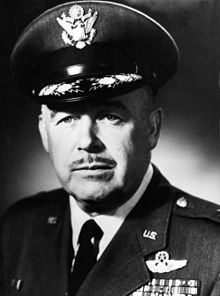Years of service 1940-1968 Rank Major general | Name Carroll McColpin Died November 28, 2003 | |
 | ||
Born November 15, 1914Buffalo, New York ( 1914-11-15 ) Awards UK Distinguished Flying CrossLegion of Merit with two Oak Leaf ClustersAir Medal with six Oak Leaf ClustersUS Distinguished Flying CrossCroix de Guerre (France)Croix de Guerre (Belgium) Place of burial Arlington National Cemetery, Arlington, Virginia, United States Service/branch | ||
Allegiance United States of America | ||
Major General Carroll W. McColpin (1914–2003) was a United States Air Force officer who served during World War II, and during the Cold War. Prior to the United States entry into World War II, in November 1940, he volunteered for duty with the Royal Air Force and was commissioned a pilot officer (second lieutenant) in the RAF before transferring to the United States Army Air Forces in the grade of major, at London, England, in September 1942.
Contents
His decorations include the Legion of Merit, Air Medal with six Oak Leaf Clusters and the British Distinguished Flying Cross. McColpin was credited with 12 kills, 5 probable, and 12 damaged while with the Eagle Squadrons. In both services he could have claimed a minimum of ten more Luftwaffe aircraft of mixed types destroyed on the ground by attacking German airfields in France and Germany. McColpin scored another 8 confirmed kills while in the Army Air Force.
Early years
Carroll Warren McColpin was born in Buffalo, New York in 1914 and was raised and educated in Los Angeles, California. He participated in civilian flying activities in Los Angeles, and in 1936 obtained his pilot's certificate. As a young man, he had built his own airplane and taught himself the basics of stick flying and aerial acrobatics by the age of sixteen.
RAF Service
Despite official US disapproval, going via Canada to England where he joined the Royal Air Force in November 1940.
After serving initially with the RAF's 607 Squadron in May 1941 McColpin joined the second Eagle Squadron, No. 121 Squadron, as a pilot and then went to No 71 Squadron, the 1st Eagle Squadron. In November 1941 he was awarded the British Distinguished Flying Cross. The award was made personally by King George VI. In January 1942 he was posted as a flight commander to the 3rd Eagle Squadron No. 133. McColpin went back to the United States in June 1942 to participate for 10 weeks in a War Bond tour followed by 4 weeks home leave. On his return, being an American, an ace and having served in combat with all three Eagle Squadron, McColpin was appointed to command 133 Squadron.
General McColpin was the only American to fly combat in all three RAF American Eagle Squadrons. His total missions in these Squadrons exceeded three hundred counting the ones he flew with the 607. He was a double ace before Pearl Harbor and was the first American to be decorated, in Buckingham Palace by King George during World War II.
USAAF Service
On America's entry into the war, and the arrival of the United States' Eighth Air Force in Britain the US Eagle Squadron personnel and equipment transferred to the United States Army Air Forces in September 1942 and McColpin was appointed to the rank of Major and the command of the 336th Fighter Squadron, 4th Fighter Group. Returning to the United States in 1943, he was assigned duty as assistant deputy for operations, III Fighter Command, Drew Field, Florida, and he subsequently assumed command of the 407th Fighter Bomber Group at Lakeland Field, Florida. in September of that year.
In January 1944, General McColpin was appointed commander of the 404th Fighter Bomber Group at Myrtle Beach Field, South Carolina, and moved that unit overseas to England where he remained in command through the English, French and Belgian campaigns.
In December 1944, General McColpin transferred to the XXIX Tactical Air Command as director of combat operations. He returned to the United States in March 1945 and served as deputy and later as commander of the III Fighter Command Gunnery School at Pinellas Field, Florida until February 1946, when he proceeded to Germany to command the 365th Fighter Group at AAF Station Schweinfurt.
USAF Service
General McColpin returned to the United States from Germany in October 1947, to command the 31st Fighter Group at Turner AFB, Albany, Georgia, until February 1950, when he entered the Armed Forces Staff College as a student. Upon his graduation from the Armed Forces Staff College in July 1950, General McColpin was assigned to the Continental Air Command at Mitchel AFB, New York, and later to the Air Defense Command, at Ent AFB, Colorado Springs, Colorado, as director of operations and training. In June 1952, he was transferred to Eastern Air Defense Force Headquarters at Stewart AFB, New York as the deputy for operations, where he remained until entry into the Air War College in July 1954.
After graduation from the Air War College in June 1955, General McColpin assumed command of the 64th Air Division (Defense) at Pepperrell Air Force Base, St. Johns Newfoundland, Canada. He was transferred to Headquarters North American Air Defense Command, Colorado Springs, Colorado, on August 1, 1958, as director of operations and served in that capacity until July 1962.
General McColpin commanded the San Francisco Air Defense Sector at Beale AFB, California, from August 1962 to June 1963, before his assignment as commander, Portland Air Defense Sector, Adair Air Force Station, Oregon.
In October 1964, General McColpin was named vice commander, 28th Air Division (SAGE), headquartered at Hamilton Air Force Base, California. He later became commander, Fourth Air Force at Hamilton on 1 April 1966.
He retired on September 1, 1968.
